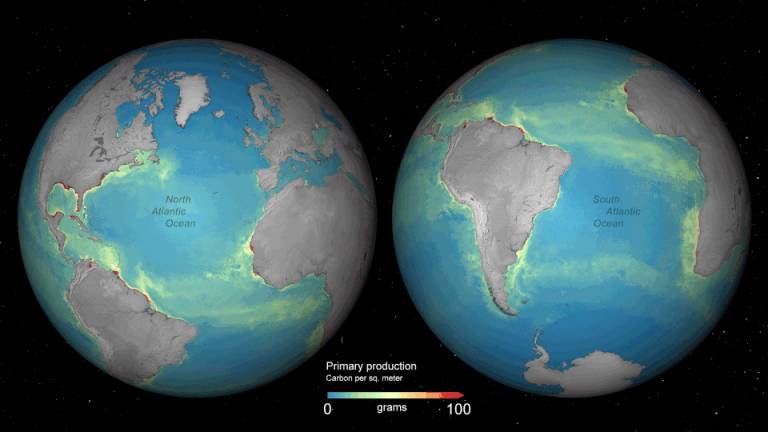The Ediacaran Shuram Excursion - new research published in Nature.
24 January 2022
This research investigates organic-rich shales deposited in South China during the late Ediacaran Period (ca. 560-551 Ma) and provides an exceptional opportunity to understand the evolution of the paleoenvironmental conditions during this period.

Picture footnote: Modern global primary productivity levels. The production of photosynthetic organic matter increases and decreases coinciding with major Earth system processes. Copyright ©: Ocean Colour CCI, Plymouth Marine Laboratory/ESA.
Interestingly, the most negative carbon isotope excursion in Earth history, known as the Shuram excursion, is recorded in these deposits. Results obtained from carbon and nitrogen isotopes, together with Raman structural heterogeneities observed in the organic matter, described a dynamic environmental scenario where a new equilibrium in the C and N cycles was established. In this new scenario, high levels of primary production of organic matter produced a change from heterotrophic to autotrophic metabolic dominance, which became the main source of organic matter in sediments and modulated the recovery of the Shuram excursion to pre-excursion values.
Dr Fuencisla Cañadas writes about her esearch:
“My research includes early Earth paleoenvironmental reconstructions to understand the interplay between major environmental changes and biological evolution. I seek to constrain the environmental conditions required for life to emerge and evolve, and its applicability and astrobiological implications on other terrestrial planets, like Mars.
Currently, I’m a Marie Curie postdoctoral fellow at the Centre for Astrobiology (Spain) working on the MaPLE (Mars Phosphorus and Life) project which investigates the P and Fe cycles evolution and nutrient availability during the Mesoarchean (~ 3 Ga) in a carbonate and iron-rich environment. This environment is used as analogue for the Jezero crater, in Mars, where the rover Perseverance, from the NASA Mars 2020 mission, searches for signs of ancient life.
Could carbonates on early Mars have accumulated enough dissolved P to become favourable environments for the emergence and evolution of life? I hope to answer this question soon!
Links:
- Extensive primary production promoted the recovery of the Ediacaran Shuram excursion. Cañadas, F., Papineau, D., Leng, M.J. et al. Nature Commun 13, 148 (2022). DOI
- Dr Fuencisla Cañadas PhD profile, lead author of the study completed her study at UCL under the supervision of Dr D. Papineau.
- Dr Dominic Papineau's academic profile
 Close
Close

